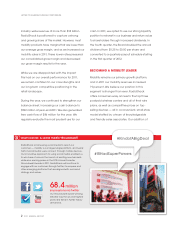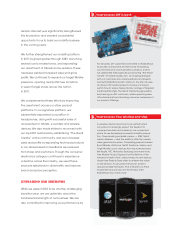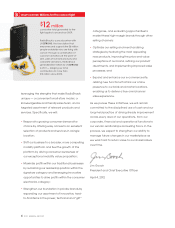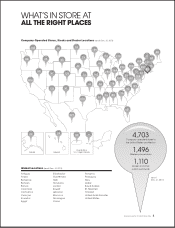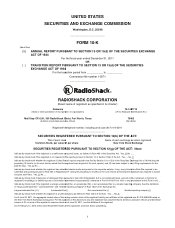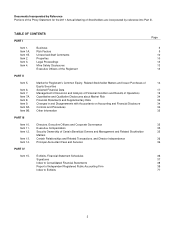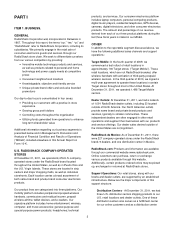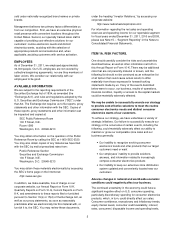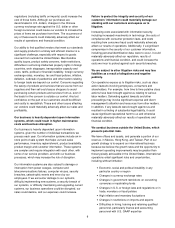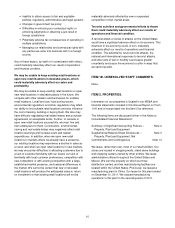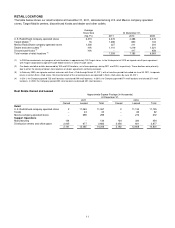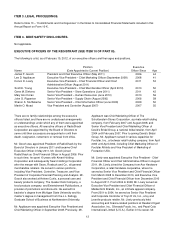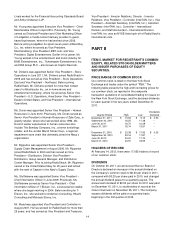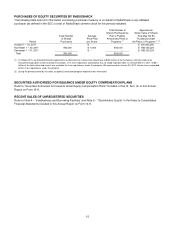Radio Shack 2011 Annual Report Download - page 14
Download and view the complete annual report
Please find page 14 of the 2011 Radio Shack annual report below. You can navigate through the pages in the report by either clicking on the pages listed below, or by using the keyword search tool below to find specific information within the annual report.6
energy prices, job growth, income tax rates and
unemployment rates may affect the volume of customer
traffic and level of sales in our locations. Continued
negative trends of any of these economic conditions,
whether national or regional in nature, could materially
adversely affect our results of operations and financial
condition.
In addition, potential disruptions in the capital and credit
markets could have a significant effect on our ability to
access the U.S. and global capital and credit markets, if
needed. These potential disruptions in the capital and credit
markets could materially adversely affect our ability to
borrow under our credit facility, or materially adversely
affect the banks that underwrote our credit facility. The
availability of financing will depend on a variety of factors,
such as economic and market conditions, the availability of
credit, and our credit ratings. If needed, we may not be able
to successfully obtain any necessary additional financing on
favorable terms, or at all.
Our inability to increase or maintain profitability of our
operations could materially adversely affect our results
of operations and financial condition.
A critical component of our business strategy is to improve
our overall profitability. Our ability to increase profitable
sales in existing retail locations may be affected by:
• Our ability to offer and sell products with sufficient
gross profit to improve our overall profitability
• Our success in attracting customers into our retail
locations
• Our ability to choose the correct mix of products to
sell
• Our ability to keep our retail locations stocked with
merchandise customers will purchase
• Our ability to maintain fully-staffed retail locations
with appropriately trained employees
• Our ability to remain relevant to the consumer
• Our ability to sustain existing retail channels such as
our Target Mobile centers
Our products and services must appeal to a broad range of
consumers whose preferences cannot be predicted with
certainty and are subject to frequent change. Our success
depends upon our ability to anticipate and respond in a
timely manner to trends in consumer preferences relating to
consumer electronics. If we fail to identify and respond to
these trends in a timely manner, our sales may decline.
In addition, consumer spending remains uncertain, which
makes it more challenging for us to maintain or grow our
operating income. As a result, we must continue to control
our expense structure. Failure to manage our labor and
benefit rates, advertising and marketing expenses, or other
store expenses could delay or prevent us from achieving
increased profitability or otherwise have a material adverse
effect on our results of operations and financial condition.
Any reductions or changes in the growth rate of the
wireless industry or other changes in the dynamics of
the industry could materially adversely affect our
results of operations and financial condition.
Sales of wireless handsets and the related commissions
and residual income constitute a majority of our total
revenue. Consequently, changes in the wireless industry,
such as those discussed below, could materially adversely
affect our results of operations and financial condition.
Lack of growth in the wireless industry tends to have a
corresponding effect on our wireless sales. Wireless
handsets are subject to significant technological changes,
and it is possible that new products will never achieve
widespread consumer acceptance or will be supplanted by
alternative products and technologies that do not offer us a
similar sales opportunity or are sold at lower price points or
margins. Because growth in the wireless industry is often
driven by the adoption rate of new wireless handset and
wireless service technologies, the absence of these new
technologies, our suppliers not providing us with these new
technologies, or the lack of consumer interest in adopting
these new technologies, could materially adversely affect
our results of operations and financial condition.
Another change in the wireless industry that could
materially adversely affect our business is wireless industry
consolidation. Consolidation in the wireless industry could
lead to a concentration of competitive strength within a few
wireless carriers, which could materially adversely affect
our business if our ability to obtain competitive offerings
from our wireless suppliers is reduced or if competition
increases from wireless carrier stores or other retailers.
Our competition is both intense and varied, and our
failure to effectively compete could materially
adversely affect our results of operations and financial
condition.
In the retail consumer electronics marketplace, the level of
competition is intense. We compete with consumer
electronics retail stores as well as big-box retailers, large
specialty retailers, discount and warehouse retailers, and
Internet retailers. We also compete with wireless carriers’
retail presence, as discussed above. Some of these
competitors are large, have great market presence, and
possess significant financial and other resources, which
may provide them with competitive advantages over us.
Changes in the amount and degree of promotional intensity
or merchandising strategy exerted by our current and
potential competitors could present us with difficulties in
retaining and attracting customers. In addition, pressure


